 |
|
|
|
 |
| Dashain |
| The greatest Hindu festival |
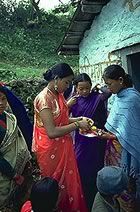 |
|
It is said that Lord Rama fought hard in the battle with Ravana but Rama was successful only when he evoked Goddess Durga, the Divine Mother.
According to Hindu scriptures, Goddess Durga slew the ferocious demon Mahisasura (Mahis + Asura), a demon in the form of a water buffalo, which terrorized people at different parts of the Earth. The almighty Durga in her various manifestations, names and forms is widely acclaimed with numerous pujas or worships for freeing mankind from the terror.
Days before Dashain, people cleanse their houses with cow dung and decorate them. They go on a shopping spree for new clothes, gifts, luxuries, foodstuffs and offerings to gods. A large number of ducks, sheep, goats and water buffaloes are brought to the capital from various parts of the nation weeks before the festival.
Most of the government and private offices are closed for eight days beginning from Fulpati (Phulpati), the seventh day of Dashain except for educational institutions, which remain closed throughout the festival.
The first nine days of Dashain are known as Nava Ratri, and Goddess Durga is adored for nine consecutive days in her nine different forms. According to Hindu mythology, those who take a holy bath for the nine straight days of Nava Ratri will not suffer from any skin disease.
A special place is arranged for Ghatasthapana, the ceremonial installation of a sacred water jar, on the first day of Dashain where barley and maize seeds are sown in sand. The room is darkened to get yellow shoots, popularly known as Jamara, from the seeds. Either a priest or the head of the family should worship the jar at a moment prescribed by pundits in that Durga is said to alight on the vessel for as long as a mustard seed can stand on a cow's horn. A national holiday is observed on this day. Then the holy jar is believed to have turned into Durga and is worshipped till Vijaya Dashami, the tenth day of victory, scarifying either a he-goat or chopping a pumpkin every day. Customarily, all the sacrificial animals should be uncastrated males and they should not have any deformity. Sacrifice of female animals is rare.
The seventh day of Dashain festival - the Phulpati
On Fulpati (or Phulpati) ,the seventh day of Nava Ratri, which means holy flowers and leaves, five Magars carry a palanquin of flowers and sacred leaves from Gorkha Durbar, the ancestral royal palace of the ruling monarchy, all the way to Kathmandu which is finally kept at Tundikhel for the audience of Their Majesties. The monarchs are offered a 31-gun salute on the occasion. Later the fulpati is taken to the temple of Taleju, one of the forms of Goddess Durga, at Hanumandhoka, the old royal palace. Then the palanquin is taken to the royal Dashain ghar at the Narayanhiti Royal Palace amid a procession.
Then comes Maha Astami, the day of great sacrifice. Hundreds of goats, sheep, chickens and ducks are sacrificed at the temples of Durga. The animals and fowls symbolize human weaknesses. Buffaloes, goats and sheep for instance symbolize anger, lust and stupidity while chickens and ducks symbolize timidity and apathy respectively. Innumerable buffaloes are slaughtered either by slashing, hacking, piercing, slitting or severing their heads in the temple of Taleju. At homes too, most of the sacrifices are made and a lot of meat is consumed on this day.
The seventh day of Navaratri, Phulpati also marks the beginning of official weeklong Dashain holidays in government offices. On the day of the auspicious Phulpati, an assortment of sacred shrubs that are offered to Goddess Durga - is taken inside the Dashain Ghar in Hanumandhoka. The Phulpati is carried by six Magar people on foot from Gorkha all the way up to Dhading district from where six Brahmins carry them to Jamal. From Jamal, the Phulpati is taken to Dashain ghar.
The eighth day of Dashain festival - the Mahashtami
Tens of thousands of Hindu devotee throng temples of Goddess Durga on this day and some of them sacrifice animals such as goats and chicken as offering to the Goddess.
This is the day when many devotees observe a feast of meat and other choicest delicacies. The night between the eighth and the ninth day of Dashain is also observed as Kaal Ratri (Dark Night) when hundreds of animals are sacrificed in Dashain ghar in Hanumandhoka.
In recent years, however, animal rights activists have been increasingly advocating for violence-free Dashain. They have been publicly campaigning for either vegetarianism or, at least, making sure that the animals do not suffer when they are killed. They claim that most of the time animals are mercilessly killed by slitting their throat.
The ninth day of Dashain festival - the Mahanawami festival
On the ninth day, people throng to nearby temples of Durga or Kali and statues of Durga are erected at different places for Dashain alone where devotees offer money and animals<. Again on this day the army officially sacrifice water buffaloes in large numbers at Hanumandhoka. On Nawami, the ninth day sacrifices are also made to Durga beseeching protection for vehicles and their occupants. All types of factories and workshops are closed and all implements and tools are worshipped and they must remain idle on this day.
Mahanawami marks the last day of Navaratri festival that begins with Ghatasthapana. For nine consecutive days, people worship Goddess Durga in their households, which culminates on the tenth day as Vijaya Dashami.
On the occasion of Mahanawami, tens of thousands of devotees throng at temples of the Goddess across the country.
The historic temple of Taleju located in Hanumandhoka is also opened on this day. This is the only day in whole year when the Temple of Taleju is opened for devotees.
On the day of Mahanawami, special Puja is offered to Kot (armory) and Jangi Nishan (insignia of armed forces) in the barracks of Nepalese Army.
The festivities reach the heights on Vijaya Dashami otherwise known as Tika. All sacrifices come to an end this day. It is said that Rama gained victory killing Ravana and Durga slaying Mahisasura. Hence, Vijaya Dashami, the tenth day of victory. This is the day of family reunion and get-togethers with relations. Elders are especially visited to receive tika, a paste of vermilion, rice and curd and Jamara from them. Tika is the symbol of triumph and power of female deities. Therefore, the elders, while putting tika on the forehead of their juniors, read out the blessings in Sanskrit, which runs like this:
|
This literally means "May you have the longevity of Drona's son Ashwotthama, riches of Dasharath, power of Raghav or Rama to finish enemy, glory and property of Nahush, swiftness of air, dignity of Duryodhana, generosity of Soorya's son Karna, strength of Haladhar or Bala Ram, truthfulness of Kunti's son Yudhisthir, knowledge and wisdom of Bidur and name and fame of Narayan."
Dressed in their best attires, people move from one place to another to convey their respects, receive tika and blessings, exchange greetings and partake of sumptuous food and drink. Some communities receive tika on the tenth day only while others enjoy rest of the five days too. Those who put on tika to juniors are offered some gifts and those who receive tika are offered fruits and snacks afterwards.
Their Majesties the King and the Queen also receive tika from the chief of the royal priests and their elders and a 31-gun salute is offered on the occasion. The King also bestows tika to the heads of constitutional bodies, ministers, foreign dignitaries, government officials and the commoners alike amid a function at the Narayanhiti Royal Palace on this day. A large number of people throng the royal palace to receive tika from the monarch. Swings of various types are one of the major attractions of the festival. Even the old people swing in the belief that one should relieve the mother earth of one's burden at least once a year on Vijaya Dashami. Children and teenagers enjoy swings most. Swings in most cases are special to Bada Dashain and Tihar principally in the countryside.
The last day of Dashain festival - the Kojagrat Poornima
The last day of the festival is Kojagrat Poornima meaning 'who remains awake.' To keep themselves awake people gamble during the night in a belief of pleasing Laxmi, the Goddess of Wealth. She is worshipped on this day. Then life reverts back to normal. And people tighten their belts to repay loans and advances spent lavishly during the festival. Observance of Dashain is believed to bring prosperity to people and rescue them from all miseries.
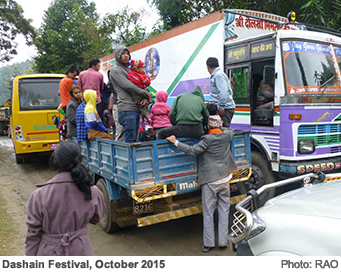 |
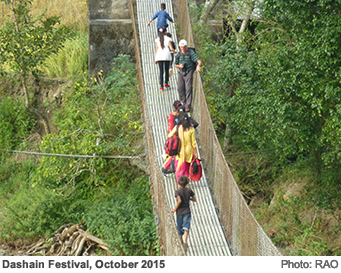 |
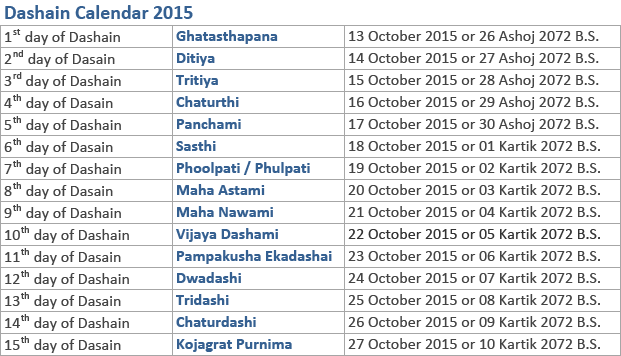 |
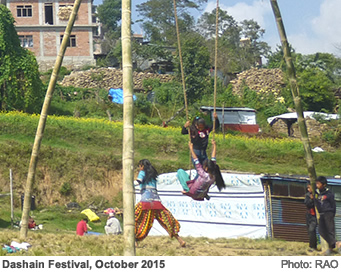 |
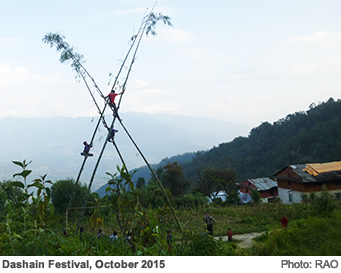 |
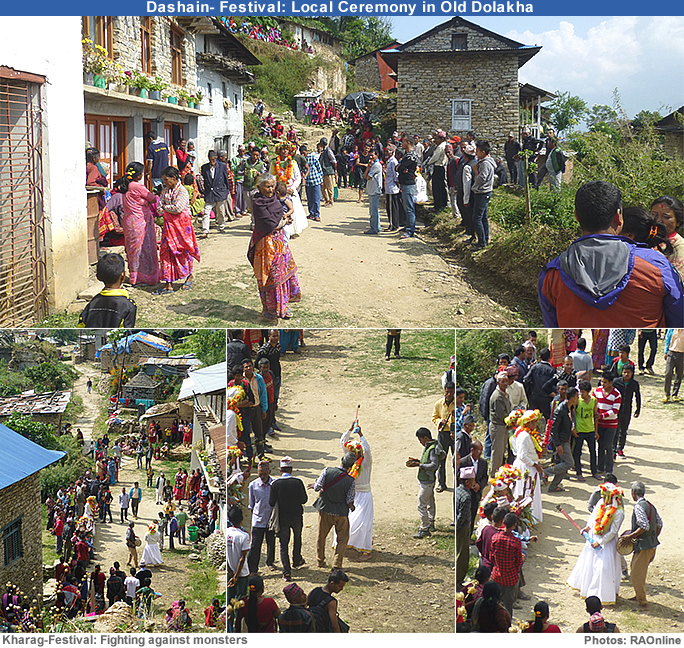 |
 |